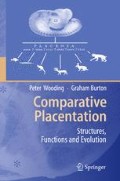The range of placental structures found in the different mammalian orders makes the prospect of spontaneous hybridisation very unlikely. By definition the species are non hybridising groups so even though the detailed placental structures here are similar, other postzygotic factors block crossing even between closely related species. There are exceptions, kangaroos will cross fertilise interspecifically (references in O’Neill et al. 1998) and recently guanaco inseminated with camel sperm produced one offspring (Skidmore et al. 1999) but usually the success rate is low, live healthy neonates unusual and fertile crosses even rarer. The development of in vitro fertilisation and embryo transfer techniques has improved the success rates significantly and raised the possibility of increasing the breeding stock of endangered species such as Prezwalski horses raised in normal horses (Allen et al. 1986) and rare bovine species raised in standard cattle (Durrant and Benirschke 1981). The exact nature of the trophoblast genotype is another important factor, as Mus musculus will only produce live births of Mus caroli if the inner cell mass of caroli is camouflaged by injecting it into a musculus blastocyst (Rossant and Frels 1980). Other interspecific mouse crosses have revealed that one of critical loci for placental development maps to the proximal part of the X chromosome (Zechner et al. 1996). The X chromosome is imprinted in the extraembryonic tissues, with genes on the maternally inherited X being expressed. Similar results have been produced in sheep and goat crosses (Fehilly et al. 1984). However these are rare examples and it is clear that even with very similar placental structures, immunological and endocrinological imbalances will rapidly terminate gestation in interspecific crosses (Allen et al. 1987; Crepeau et al. 1989).
Access this chapter
Tax calculation will be finalised at checkout
Purchases are for personal use only
Preview
Unable to display preview. Download preview PDF.
Rights and permissions
Copyright information
© 2008 Springer-Verlag Berlin Heidelberg
About this chapter
Cite this chapter
(2008). Hybridisation, Cloning and Fetal Origins of Adult Disease. In: Comparative Placentation. Springer, Berlin, Heidelberg. https://doi.org/10.1007/978-3-540-78797-6_10
Download citation
DOI: https://doi.org/10.1007/978-3-540-78797-6_10
Publisher Name: Springer, Berlin, Heidelberg
Print ISBN: 978-3-540-78796-9
Online ISBN: 978-3-540-78797-6
eBook Packages: Biomedical and Life SciencesBiomedical and Life Sciences (R0)

